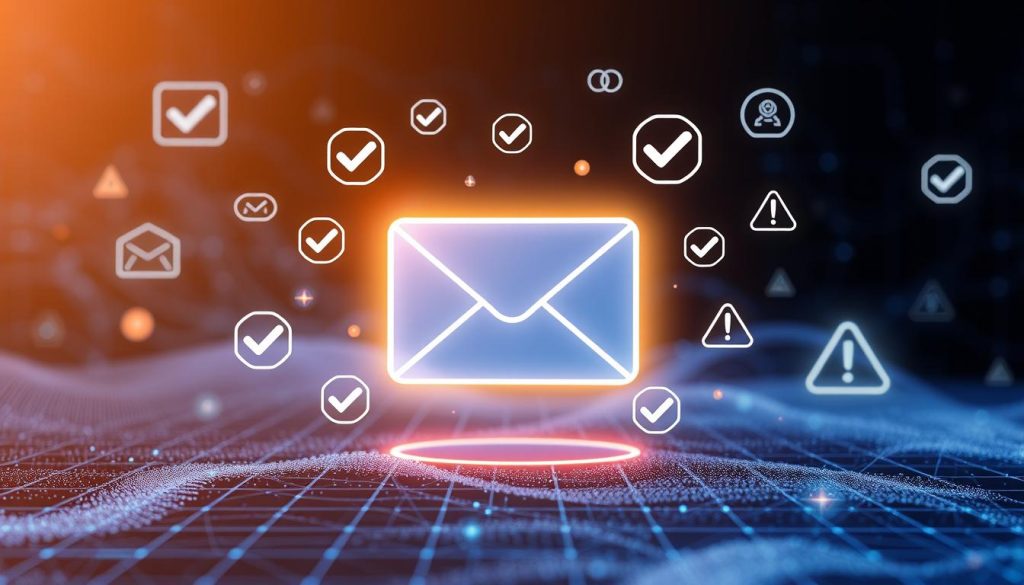Did you know that 80% of cold emails to unverified lists bounce, causing email blocks? This shows how vital it is to check your email lists before sending out. Cold emails to unverified lists can harm your reputation and lower your email delivery rates. This can hurt your marketing success.
In this article, we’ll look at the risks of cold emails to unverified lists. We’ll also share ways to make your email campaigns work well and keep your reputation safe. By using the right cold email marketing strategies, you can get better leads, more engagement, and clear results for your business.
Key Takeaways:
- Sending cold emails to unverified lists can lead to high bounce rates, spam complaints, and email account blocks, harming your sender reputation and email deliverability.
- Email verification is crucial to clean out invalid, inactive, or risky email addresses, improving the quality of your prospect list and increasing response rates.
- Utilizing email verification tools can protect your sender reputation, enhance email engagement, and optimize the return on investment for your cold email campaigns.
- Adhering to best practices for cold email outreach, such as personalizing messages, limiting sending volume, and maintaining proper text-to-HTML ratios, can help you avoid email account blocks and ensure successful deliverability.
- Continuous monitoring of email metrics and adjusting your strategies based on performance data is essential for fine-tuning your cold email campaigns and achieving optimal results.
What is Cold Email?
Cold emailing is a way to reach out to people you’ve never met before. You send them emails that are very personal. The goal is to start a relationship and maybe even get them to buy from you.
This method is used by many businesses. They use it to find new customers and grow their sales.
Building Relationships through Cold Email
Cold emailing is all about making connections. You send emails that really speak to the person’s needs. This grabs their attention and opens the door for more.
Cold Email helps you introduce your products in a way that matters to them. This can lead to new customers and stronger relationships.
“A successful cold email campaign can achieve over a 70% conversion rate, significantly boosting revenue for businesses.”
Cold emailing is different from other email methods. It’s all about giving the recipient a personal and valuable experience. By understanding their problems and offering solutions, you build trust. This can lead to a lasting relationship.
Done right, cold emailing is a smart and affordable way to reach lots of people. By following best practices and improving your approach, you can get great results. This can help your business grow in big ways.
Why Do Email Accounts Get Blocked by Sending Cold Emails?
Many think sending cold emails can block their email accounts. But, this isn’t true. Email accounts aren’t blocked just for sending cold emails. It’s breaking rules and certain practices that can cause blocks.
Planning well, following best practices, and avoiding mistakes can keep your account safe. This way, your cold email campaigns won’t block your email account.
The Truth About Cold Email and Account Blocking
Email accounts don’t get blocked for sending cold emails if done right. HubSpot found that 15.8% of emails don’t reach their recipient’s inbox. This happens due to issues like outdated records or using spam words.
Using special email accounts for campaigns helps keep your main domain safe. Starting small and growing your email numbers can also help. This builds trust with email services and avoids being seen as spam.
Choosing verified email addresses lowers bounce rates and boosts reputation. But, adding links, attachments, or bullet points can mark emails as spam. Personalizing and avoiding unnecessary tracking can improve your email’s success.
Knowing why email accounts get blocked helps you use cold email safely. This way, you can avoid The Consequences of Sending Cold Emails to Unverified Lists and keep your emails delivered.
Reasons Why Your Email Account Gets Blocked
Sending cold emails can lead to your account getting blocked. It’s important to know why this happens. This knowledge helps you avoid problems and keep your emails reaching their destination.
Neglecting Email Authentication Protocols
Not setting up SPF, DKIM, and DMARC can block your email account. These protocols help email services know if your emails are real. Without them, your emails might look like spam.
Excessive CC and BCC Usage
Using too many CC or BCC recipients can also block your account. Email services see this as a way to avoid spam filters. This can lead to your account being blocked.
Recipient Spam Complaints
When people mark your emails as spam, it hurts your reputation. Many complaints can get your account blocked. Email services see it as a sign of spamming.
Sending to Unverified Lists
Using unverified lists for cold emails can cause high bounce rates. This looks like spamming or bad list management. It might get your account blocked.
To avoid these issues, follow best practices. Make sure your emails are authenticated, warm up your account, and verify your lists. These steps help keep your reputation good and prevent account blocks.
| Reason | Explanation |
|---|---|
| SPF, DKIM, and DMARC records not updated | Failure to set up proper email authentication protocols can raise red flags with email service providers. |
| Sending emails with multiple recipients in CC or BCC | Excessive use of CC or BCC fields can trigger spam filters and be viewed as a tactic to bypass spam detection. |
| Multiple recipients mark your email as spam | Spam complaints from recipients can severely damage your sender reputation, leading to email account blocking. |
| Sending cold emails to an unverified list | High bounce rates from an unverified list can be interpreted as potential spamming or poor list management. |
“Proper email authentication is crucial for maintaining a positive sender reputation and avoiding email account blocking.”
Exceeding Daily Email Quota
Sending cold emails has its limits. Email service providers set daily quotas to stop spam. Going over these limits can block your email account.
In 2021, about 20% of emails didn’t make it to the inbox. This shows how important it is to follow your provider’s limits.
Services like Gmail might limit you to 500 emails a day. If you send more, your campaigns could pause for hours or even days. Or, your account might get suspended or banned, leading to a longer pause.
To avoid trouble, keep an eye on how many emails you send each day. Make sure you don’t go over your provider’s limits. This way, you can avoid getting your account blocked and keep your emails reaching their destination.

It’s best to send no more than 50 cold emails a day. Sending more can make you look like a spammer. This could get your account blocked.
Using Spam-Triggering Words in Your Email
In the world of cold email outreach, some words can make or break your campaign. Email providers use advanced algorithms to check your emails for spam. Words that trigger spam can hurt your email’s delivery and might even block your account.
Words like “free,” “limited time offer,” and “guaranteed” can be trouble if used too much. Keeping a good sender reputation is key for email delivery. Providers look at your email engagement, spam complaints, and bounce rates to judge your emails.
Avoid spam words and focus on personalized, valuable messages. Using emojis wisely, authenticating your emails, and sending consistently can help. These steps can help you avoid spam filters and improve your email delivery.
Understanding the impact of spam words can make your cold email campaigns better. It helps you build stronger connections with potential clients.
“The use of spam-triggering words can significantly impact the deliverability of your cold emails, sometimes leading to your email account being blocked altogether. It’s crucial to be mindful of the language you use and focus on creating personalized, value-driven messages.”
Not Choosing the Right Email Service Provider
Choosing the right email service provider (ESP) is key for cold email success. A good ESP is reliable, follows industry standards, and keeps your emails delivered. Using a bad ESP can harm your sender reputation and lead to account blocks.
A good email bounce rate is 2% or less. If your bounce rate is higher, you need to improve it. Aim for a 70 or higher email reputation score to start cold emailing safely. Using SPF, DKIM, and DMARC can help keep your emails delivered.
Keep your cold emails between 150 to 250 words. Send them at different times and in varied quantities to avoid being seen as spam. Changing ESPs too often can hurt your reputation. Cold emails usually have a 20-30% open rate and a 0.5%-3% click-through rate.
Cold emailing lets you track your results and improve your campaigns. Personalized emails can engage more people, making your content more relevant. It also helps you target the right people, increasing your chances of success.
Best Practices to Send Cold Emails Without Getting Blocked
To send cold emails without getting blocked, follow best practices. These guidelines help keep your sender reputation positive. They also boost your cold email campaign’s deliverability.
Use a Reputable Email Service Provider
Choose a reliable email service provider (ESP) known for good compliance and high deliverability. MailChimp, ActiveCampaign, or HubSpot are great options. They offer tools to manage your cold email outreach well.
Authenticate Your Emails
Use email authentication like SPF, DKIM, and DMARC to prove your emails are real. This stops your messages from being seen as spam. It makes sure they get to your prospects’ inboxes.
Warm Up Your Email Account
Start with a few emails and slowly send more. This warming up helps your sender reputation. It lowers the chance of your account getting blocked.
Create a Hyper-Targeted Prospect List
Do deep research to find the right people to contact. Make your messages personal by focusing on their interests and problems. This can lead to better responses and a good sender reputation.
Verify Email Addresses Before Sending
Check the email addresses on your list before sending. This reduces bounce rates and avoids spam filters. It helps keep your email deliverability high.
“Properly setting up SPF, DKIM, and DMARC records for email deliverability is crucial to avoid being marked as spam.”
By sticking to these best practices, you can send cold emails safely. Keeping a good sender reputation and ensuring your emails get through are key to cold email success.
The Importance of Email Verification
Verifying email addresses is key to successful cold email campaigns. Sending emails to wrong addresses can lead to high bounce rates. This can hurt your sender reputation and how well emails get delivered.
Email service providers watch bounce rates closely. A high rate might mean you’re spamming or managing your list poorly. This could block your email account.
Verifying emails before sending can prevent these problems. A study by Return Path found 83% of email delivery issues come from sender reputation. Another study showed 20% of legit emails never reach the inbox because of bad sender reputation.
It’s important to check your email list regularly. An email list can lose about 22.5% of its value each year. Verifying your list every three months or twice a year can help. It removes bad addresses, improves deliverability, and makes your emails more effective.
| Benefit | Impact |
|---|---|
| Decreased bounce rates | Improved sender reputation and email deliverability |
| Refined email list | Removal of inactive or non-existent addresses, better engagement metrics |
| Enhanced outreach effectiveness | Reaching the right prospects with a higher chance of conversion |
Bad email lists can hurt your domain reputation. It might even get your account suspended or marked as spam. To avoid this, use best practices like double opt-in and regular list cleaning.
Email verification services can help find and remove bad addresses. Using email authentication like SPF, DKIM, and DMARC can also boost trust with ISPs and recipients. This improves your email reputation.
Email verification is very important. By verifying your emails and keeping your list clean, you can improve your cold email success. This will also help build a good sender reputation for the future.

How to Verify Cold Emails
Keeping your email reputation healthy is key for cold email success. Sending to unverified lists can harm your reputation and land you in spam. It’s vital to verify email addresses before sending.
Free Email Verification Tools
Many free email verification tools help check if an email is valid. They’re great for a few emails but not for big lists.
Email Search + Verification
BounceShield by LeadLoft offers real-time verification for your emails. It makes sure every email is valid and adds it to your CRM. This keeps your sender reputation strong.
Bulk Verification
For big lists, like newsletters, NeverBounce has affordable bulk verification. It checks thousands of emails fast, ensuring you reach the right people.
BounceShield by LeadLoft
BounceShield by LeadLoft can verify even hard-to-check emails. This reduces bounce rates and keeps your reputation healthy, crucial for cold email success.
Using these tools and best practices ensures your cold emails reach the right people. This boosts your email deliverability and strengthens your sender reputation. It helps you stand out in a crowded inbox.
Conclusion
Sending cold emails to unverified lists can lead to serious issues, like your email account getting blocked. To avoid these problems and make our cold email campaigns successful, we need to follow some key steps. These include using a reliable email service, setting up proper email authentication, and warming up our email accounts.
We should also create a list of prospects that are very specific and verify their email addresses before sending. By doing this, we protect our reputation as senders, improve how well our emails get delivered, and find more qualified leads for our business.
Following these best practices helps us avoid the risk of our email accounts getting blocked. It also boosts the success and return on investment of our cold email marketing. As we keep working to make our strategies better, we can confidently connect with our target prospects. This leads to meaningful relationships and real results for our organizations.
FAQ
What is cold emailing?
Cold emailing is a way to reach out to people you’ve never met before. You send them emails that are tailored just for them. The goal is to start a relationship and maybe even get them to buy from you.
Why do email accounts get blocked by sending cold emails?
It’s a myth that cold emails can block your email account. If you send cold emails the right way, your account won’t get blocked.
What are the reasons why an email account gets blocked?
There are a few reasons. Not setting up email authentication correctly is one. Sending emails to too many people at once is another. If people mark your emails as spam, or if you send to unverified lists, your account might get blocked.
What happens if I exceed the daily email sending quota?
Email providers have limits on how many emails you can send each day. Going over these limits can make them think you’re spamming. This could lead to your account getting blocked.
How can using spam-triggering words in my email affect my account?
Email providers use special algorithms to check for spam. Using certain words can make your emails look like spam. This can hurt how well your emails get delivered and might even get your account blocked.
Why is the choice of email service provider important?
Choosing the right email service provider (ESP) is key for your cold email success. A good ESP follows industry rules, keeps your emails safe, and helps them get delivered. This can help avoid your account getting blocked.
What are the best practices to send cold emails without getting blocked?
To avoid getting blocked, use a trusted ESP. Make sure your emails are authenticated properly. Start slow with your emails. Target your list carefully. And always check if the email addresses are real before sending.
Why is email verification important?
Sending emails to wrong addresses can hurt your reputation. High bounce rates can make providers think you’re spamming. This could get your account blocked.
What are the different methods to verify cold emails?
There are a few ways to check if emails are real. You can use free tools, search and verify emails, or do it in bulk. BounceShield by LeadLoft is a special tool that can even verify emails that others can’t.
Source Links
- No Response from Cold Email – How to Fix it?
- Send Cold Emails Without Blocking Your Email Account
- The Best Kept Secret to Better Cold Email Response Rates: Email Verification
- All about Cold Emailing: Definition, Use Cases, and Writing Tips (2024)
- Improving your sender and domain reputation for cold email deliverability
- Email Blacklists Explained – What Are They And How Do You Avoid Them?
- How to Send Cold Emails Without Blocking Your Email Account?
- Cold Email deliverability tips to avoid SPAM filters – Nureply Blog
- Mastering Cold Email Deliverability: Your Key to Inbox Success in 2023
- 12 Reasons Your Email Deliverability Suffers and How to Fix It
- How to Solve an Error while sending a campaign – Woodpecker
- How to Send Cold Emails? Proven Techniques to Know
- Cold Email Spam Triggers: How to Avoid Them
- How to Cold Email Without Hurting Email Reputation
- How to Write Powerful Cold Emails That Get Replies – Vengreso
- How To Send Cold Emails – The ULTIMATE Guide
- How to verify email addresses before sending cold emails? (2023)
- The Hidden Dangers of Unverified Emails: Protecting Your Email Reputation
- How To Check If An Email Is Valid (Test Without Sending) + Free Tool
- Typical Cold Email Open Rates: Benchmarks and Tips to Boost Your Success – Growleady
- The Ultimate Cold Email Outreach Guide You Need | TaskDrive


